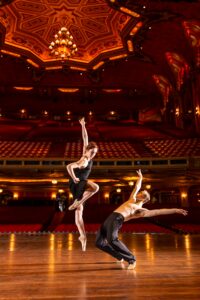
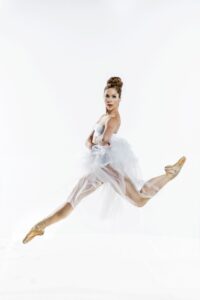
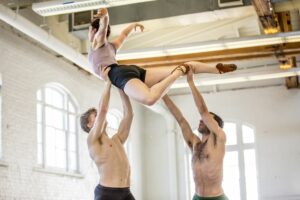
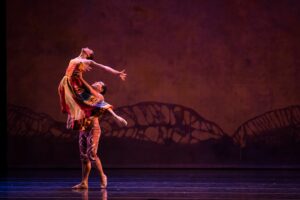
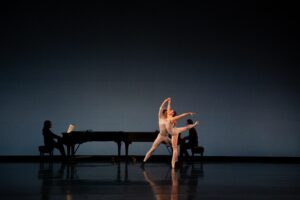
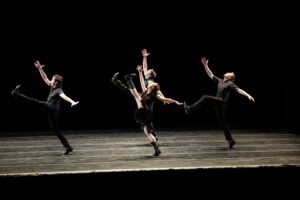
Karen Wing, a long-time member of BalletMet’s Company, is retiring this season. She has had a magnificent career spanning a decade. We had the great privilege of sitting down to talk with her about her career and her next steps in life.
She began dancing in her home state of California, at the Petaluma School of Ballet. Karen went on to earn a BFA in Dance Performance (magna cum laude) and a minor in Business Management from the University of California-Irvine, graduating in 2013. After a season with Sacramento Ballet, she joined BalletMet. Even though that early-2014 audition was almost a decade ago, she still remembers it:
That was Edwaard’s first audition tour as the Director of BalletMet. I was dancing at Sacramento Ballet at the time, having just started there out of college. I knew of Edwaard—I had seen a little bit of his work live—and knew that there was a chance that there could be a lot of change coming. As a new Artistic Director, you want to shape your company and your vision for it.
It was the first audition I did of the season, still just getting my feet wet. It was very crowded. I remember…Oh, the groups were all mixed up! Someone else went in my group, which took my spot, so I went in the wrong group with my number. I felt like, ‘Ugh, they didn’t even see me, I’m going to get cut for sure.’ But then they called my number after class, saying, “These numbers, we want you to stay and learn some choreography.” I was like, ‘Wait, what? Was that me? Oh, okay!’
Despite her group mix-up, Karen made her way easily through the rest of the audition, helped by her prior experience with Liang’s work as an understudy at Sacramento Ballet. And after the audition—
I remember getting a voicemail from Edwaard after the audition, a while later: “Hi, this is Edwaard Liang, can you give me a call back, I have a couple questions for you.” And I was just like, ‘Oh my gosh!’ It’s so funny that 9, or, well, 10 years ago now, Edwaard Liang left me a voicemail.
Upon graduating from college, Karen didn’t have so much a dream company to join, but she did have a bucket list of works and choreographers that she dreamed of working with.
So when that first conversation with Edwaard happened, he said, “I’m planning to bring in this choreographer, and I want to do this work, and that work, and…” I mean, my eyes were just getting bigger and bigger. Every name he said, I was like, ‘Oh, my gosh, that’s my bucket list’. For me, it wasn’t ever about having my eyes set on something like, ‘I have to be in this specific company.’ It was more about wanting to dance as much as I possibly could. And I wanted to do—to dance—as diverse of repertoire as I possibly could.
I had heard that about BalletMet previously. It was known for being an ensemble-type company where everybody danced a lot and the repertoire was very diverse. At that time, it kind of remained to be seen what Edwaard would do with the company, but in talking to him it really felt like, ‘Okay, he’s going to make it his own.’ Then and now, he values a lot of the things that I value. I had my hopes that it was going to be a good fit. And it was.
That post-audition conversation and later voicemail were the beginning of an amazing career. In many ways, Karen is the embodiment of a BalletMet dancer. Her experience with a variety of forms outside of classical ballet helps her adapt to the range of works that BalletMet performs. Her life outside of the dance studio gives her a depth of artistry that she brings to each role she takes on. The unique combination of her skillset, her experiences, and her own voice make her dancing instantly recognizable onstage. Karen has belonged here from the start—although she has not always felt that way. She recalls her first few days of the 2014-2015 season:
We were in Studio A, I’m sure, because back then we were always in Studio A for class. And we were working on the first Twisted. I remember feeling very overwhelmed. I was looking around the room and thinking, ‘These dancers are so amazing.’ I actually remember later telling Edwaard that, when I first came here, I immediately thought the first day that I was not going to make it because the other dancers were so amazing! I just felt like an impostor. I was always thinking to myself, ‘I don’t deserve to be here’. I really felt that I had to prove myself, if I wanted to stay.
This sense of impostor syndrome—of not being good enough—plagues many dancers. Karen Wing is a highly accomplished artist. Her skill has been recognized by Pointe Magazine, the Greater Columbus Arts Council, and several dance critics. Even so, she struggles with impostor syndrome! In this hyper-critical field, it is incredibly hard to remember the truth: Awards and accolades are not what make one a skilled artist. Awards and accolades come because one is already a skilled artist.
In Karen’s nine years as part of BalletMet, dealing with her impostor syndrome has been quite the journey. What has helped is the sense of community she found at BalletMet.
I’m from California. I’m a long way from home! But the second I joined BalletMet, I felt like I was brought in by the audience, by the board, by people in this organization…I was at Lucy Porter’s memorial recently, and I was just thinking about how, before I even knew it, she had deemed me her person. Like she had claimed me. And I felt so honored that she did. That was a really cool feeling to feel, that I was just a few shows into my first season and there were people who knew me and would tell me, ‘Hey, we’re coming to see you,’ and, ‘We look for you!’, even if I was in the corps or something. It always makes you feel very valued and special, to know that your work reached out and somebody experienced it and took that in, intentionally, that it was you. That’s why I’ve been here so long, because it quickly felt like home to me and like…Even though I struggled with it the whole time through! I did feel that I belonged, and that I had a place here.
She has also taken on a role as a mentor, reaching out to the Trainees and members of BalletMet 2.
I’ve really enjoyed the times that I’ve gotten to teach in the Academy with the summer program or, in Nutcracker, being able to work with the Trainees and BalletMet 2’s. That pre-professional age is just the hardest part. You’re no longer a student, you’re trying to be seen as a professional, you’re in-between—I often feel so much empathy for that stage and I want to offer any guidance that I can. I try to work with them, even if it’s just little things in rehearsal, like, ‘Oh, do your ports de bras this way so you blend in with the group a little more,’ or, ‘Let me tell you what I learned—here’s what didn’t go well, do it this way.’
Karen’s advice to younger dancers comes from her years of experience. Each role or process of hers led to new growth and new wisdom.
Every time you experience working with a new person or taking on a new role, it feeds you as an artist. You carry pieces of that forward with you. Then one day, you try to approach something you’ve never done before, but it’s not really all that new because you have all this past physical history within you.
That’s why I’ve always loved being part of the creative process. Working with new voices especially has been important to me. Anytime I’ve had that new influx—a choreographer or someone—that fresh energy and that special time in a process has always been something that I’ve really appreciated and valued.
Even returning to old roles holds new knowledge.
When you’ve been around long enough you start to revisit ballets that you’ve done in the past. And even going back to Oz, it’s interesting how I can remember certain steps that I struggled with and needed to rehearse more. Even if I don’t really remember something at first, it comes back as soon as I step into a turn: ‘Oh, I remember doing this.’ Having that, again, and then being able to help someone who hasn’t had that learning curve yet with this ballet or this step or the partnering—I guess you sometimes take that physical memory for granted.
Revisiting things like Nutcracker as well and realizing, ‘Wow, I know my parts, but I also know everyone else’s parts at this point’, because you’ve been around it for so long! We think about dance history and how it’s mostly taught through reading about it. But really, it’s been passed on through the teaching and the recording of movement from dancer to dancer. It’s the same way, as a professional, that you have your own personal history and journey.
I know everyone’s always like, “Ugh, Nutcracker,” but I really, I truly do love Nutcracker! That’s what got me into ballet. I think for a lot of people it is. Having that show to come back to every year has been really special. Maybe even more so this year, to be back on stage and revisit it and feel this sense of coming full circle with it all.
A key moment of Karen’s own history and journey was her 2016 interpretation of Carmen in Gustavo Ramírez Sansano’s CARMEN.maquia, which won her recognition as a Pointe Magazine Standout Performance.
That was my first principal role. And it felt like a lot of pressure. The choreographer only wanted Gabe [Gabriel Gaffney Smith] and I to do it. And it was kind of like, ‘Okay, well, really?’, ‘There’s a little bit riding on you right now!’ I’ve always struggled with that mentality of not believing in myself and my abilities and feeling like I had to prove myself to others, but I think a lot of times it was really proving myself to myself. Overcoming that huge hurdle and having it go so successfully was really a special thing. There were many things that came after that I was able to approach with a little more confidence, having had Carmen under my belt.
But going back to it in the 2019-2020 season was really different. The first time it was just this whirlwind of movement, like, ‘Can I physically move fast enough to achieve all these things that I have to do in this timeframe?’ The second time, my mind was much calmer and clearer, and I was more efficient in my movement. So it became, ‘Oh, I can get from point A to Z in the same amount of time, and I can actually think and breathe and make connections during that time.’ The rehearsal process was really fun to revisit in that.
Unfortunately, COVID-19 hit later that year. Despite high anticipation for her signature grounded fluidity, easeful mastery of fastpaced precision, and sensuality of movement, Karen’s Carmen did not return to the stage. COVID-19 did, however, bring her a choreographic opportunity. In the spring of 2021, Karen’s Verbena premiered in BalletMet’s Unlocked.
Choreographing on the company was definitely another high point. The early pandemic was such a crazy time for all of us. But it made it even more special that we were able to come together and create something. I felt very proud of what I created. It felt, again, like a huge hurdle of, ‘Oh my gosh, can I do this?’ But I was really pleased with how invested everybody was, and what we came to figure out through protocols and limited rehearsal time and having been off for 10 months and all these things. The passion that everyone had for this art form was just so apparent, because we had been deprived of it, you know?
As my first ballet teacher said, “Karen, you’re a creative person. It’s just who you are. You will always be a creative person.” I’ve been a part of the creative process, and even though it’s someone else’s vision you’re creating, there is that sense of them starting a sentence and you finishing it. I am a creative person! I realized that every time a choreographer played the music and my mind went somewhere and saw something.
Pre-pandemic, Karen created a duet with Jarrett Reimers, another former BalletMet dancer, supported by the Greater Columbus Arts Council’s and Columbus Dance Theatre’s Columbus Dance Fellowship. She also presented work with Melissa Gould’s New Vision Dance Company. Karen’s name may very well be featured in future playbills as a choreographer! In her creative work, she keeps in mind the advice she received from college mentor Donald McKayle.
Through all my struggles coming up as a dancer, what kept me going was finding my voice as an artist. Donald McKayle told me in college that dancers should tell stories with each step that they take because otherwise they were just steps and anyone could do them. He believed in me as an artist and my ability to tell stories and that always stuck with me. Coming to BalletMet, it quickly became a place where I felt that my voice was valued and was given the space to continue to grow and shine.
Both as a dancer and as a choreographer, Karen does what she can to make the field better for those coming after her.
I’ve seen the dance world change a lot, growing up in it and then being a professional. I’ve always been of the mentality that you should leave a place better than you found it. A Girl Scout mentality, or something! So, to me, things that I experienced growing up or hurdles that I had to overcome, whether they were external things or within my own brain, they were things that I wanted to make better for the future generation. It’s really probably small drops in the bucket, but if there was some way that I felt I could do that, that’s something that I made a point to do.
This art form can feel very self-serving because we focus on ourselves all day long every day trying to make ourselves better. That’s a great thing in some ways, but it also can feel very selfish or isolating. It became important to have those moments of making connections with others, or to hope that, ‘Okay, even if I felt like I was an impostor, maybe somebody looked up to me, and maybe that inspired them,’ or if they looked at me and they were like, ‘She doesn’t fit the mold, and look, she’s had a professional career, so maybe I can do it too!’ If I could be that person, then that would make me feel really good [laughs].
This intentional kindness of hers has a tangible effect on her everyday life with the Company, where she is seen as someone who can be trusted and counted on for guidance.
Sometimes I still feel the same way as the first day. Like, ‘Wow, these dancers are so talented! I really have to prove myself!’ I do, but now there’s a sense of comfort and—oh gosh [tearing up]—belonging.
Back then, it felt like this world that I was an outsider to. Now, people come to me to ask, “What’s going on?” They look to me now, asking, “What are we doing next week, going into tech week?” And I’m like, ‘Well, you know, it could be different, but it’s probably going to be like this…” It’s a huge shift, being here so long and having had that early experience, to now being that dancer that I once looked at like, ‘Oh, they’ve been here forever. They know what’s going on. They’ve got it figured out.’ Sometimes I’m still like, ‘What’s going on?’ Sometimes I feel the same way as the young new dancers. But then I realize, ‘Oh, I have been around a while!’ So now there’s definitely a sense of comfort and that change of perspective.
The last few years have undoubtedly been full of change. A global pandemic, a new child, the uncertainty of the performing arts…Dance has always been a part of Karen’s life, but her priorities are (understandably) shifting.
COVID honestly started that mental journey. No one knew what was going to happen after the pandemic. Were we going to come back? We all were hopeful, of course. But the longer that time went on, the more unsure it was of what coming back would be. How long could we hold out as artists and try to keep ourselves going, physically? Having gone to college and having struggled with impostor syndrome so badly, I’ve always had Plan B, C, D. I never wanted to feel that I had no options or be blindsided, like, ‘Oh, what will I do tomorrow?’ I always tried to keep doors open and pursue new avenues, whether it was teaching Pilates or teaching dance or choreographing or a whole other list of things outside of the dance world as well.
But I think the pandemic really gave me that time away to realize that dance is something that I love, and it’s something that I do, but it is not who I am. And that there is a separation that is actually—for me—was healthy. Being able to see that distinction and come to terms with it made me know that when the time was apparent to retire, it was going to be okay. We value ourselves so much, so heavily, based on the work that we do and it’s really like—I was realizing this—it’s like you value yourself through others’ eyes, essentially. Arriving at a place where I could value myself through my own eyes, keep my own set of opinions about my work, and who I am as a dancer and as not a dancer, was a big part of that journey.
And so was having my son. Realizing that time is so—all time is fleeting, but really—I see the changes in him daily. I wanted to really soak that all in. As much as I’m someone who always says yes to everything and wants to do it all, there comes a point where there’s always going to be a tradeoff. And so I looked back at all my years and thought, ‘You know, I’ve had a good run, a great run.’ And I’ve gotten to do so many things that I had on my bucket list that were really just—I mean, I say ‘bucket list’ but that sounds like I knew that I was going to get to do them. Maybe it was a wish list, a dream list. To have done so many things on that, and then some, and been given opportunities that I never thought I would get or could achieve success in? I felt at peace when I thought, ‘Okay, this is time to close this chapter and move to the next.’
I also really wanted to feel like I went out on a high note, and I wanted to feel like I went out on my terms. Coming off of the pandemic, and then being on maternity leave, and all, it felt like it had been a long time since I’ve really been fully back and onstage. So I—impostor syndrome at its finest!—I really struggled with coming back and feeling like, ‘Well, I’m just washed up,’ like, ‘I’ve had it, I’m done!’ like, ‘I need to get out before anyone realizes it!’
But I knew that wasn’t the truth and that I needed to push forwards. Getting back onstage and dancing to a level that I felt proud of? That, again, allowed me to have that sense of closure. I’m not running away from it. I’m gently closing the book.
We will deeply miss Karen at BalletMet, but we wish her all the best in her future journeys as a mother, an artist, and a human being. It has been a wonderful nine years with her as part of the Company. We know that even after her final bow, she will continue to inspire all who meet her through her grace and kindness.
See Karen’s last performances at March’s A Celebration of New Works; click here for more information.
Karen’s awards include:
Greater Columbus Arts Council Artists Elevated finalist (2022)
Columbus Dances Fellowship (2018)
Pointe Magazine Standout Performance (2016)
Pointe Magazine “Stars of the Corps” (2015)
Read reviews of Karen’s performances:
BalletMet friends sync up to choreograph new dance (dispatch.com)
The Standouts: Our Top 12 Favorite Performances of 2016 (pointemagazine.com)
BalletMet’s ‘Carmen.maquia’ a Lustful Triumph (artsair.art)
Dance review | ‘Carmen.maquia’: BalletMet’s Wing dazzles; show an emotional force (dispatch.com)
Years of preparation behind fresh staging of ‘Carmen’ (dispatch.com)
2015 Stars of the Corps: 10 Dancers Set to Ascend the Ranks (pointemagazine.com)
BalletMet’s Triple Bill of World Premiere Ballets Finds Beauty in Strange Situations (artsair.art)
And, from her college days:
MFA Students ‘Inspire’ | New University | UC Irvine
Responses have been edited for clarity
Written by Sara Wagenmaker
Photos by Jennifer Zmuda

